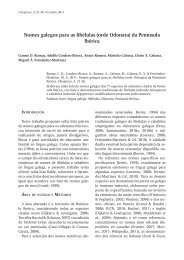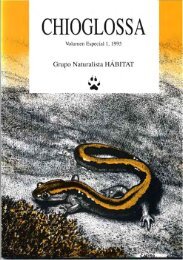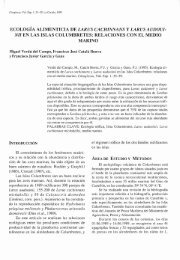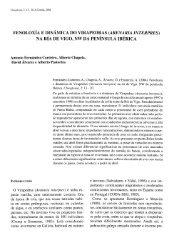1 Tr - Chioglossa
1 Tr - Chioglossa
1 Tr - Chioglossa
Create successful ePaper yourself
Turn your PDF publications into a flip-book with our unique Google optimized e-Paper software.
HERPETOFAUNA DE LAS ISLAS GALLEGAS [59<br />
SUMMARY<br />
Coronella girondica (Daudin, 1803)<br />
Culebra Lisa Meridional. Cobra Lagarteira Meridional<br />
Es el ofidio de más amplia distribución en las islas gallegas, estando presente<br />
en cinco:<br />
• Sálvora (Ca): Mateo (1990)<br />
• Cortegada (Po): Maneiro (1983), Galán y Fernández-Arias (1993)<br />
• Arousa (Po): Galán y Fernández-Arias (1993)<br />
• Ons (Po): Galán (l987a)<br />
• Monteagudo-Faro (Islas Cíes) (Po): Galán (l987a)<br />
En general, aparece ligada a los grandes afloramientos rocosos provistos de<br />
grietas, en las que busca refugio, zonas pedregosas y áreas abiertas de matorral.<br />
Maneiro (1983) comprobó en Cortegada la depredación sobre Anguis fragilis y<br />
nosotros en la isla del Faro (Cíes) sobre Podareis hispanica (un individuo adulto<br />
de esta lagartija encontrado en un contenido gástrico de Coronella).<br />
Contribution to the knowledge oj' the Galician<br />
islamis ' herpetofauna: faunistic inventorv ami notes<br />
on the ecology and mOlphology oj'some pOfJulations<br />
An inventory of the amphibian and reptilian species<br />
of the Galician islands is given in this paper. Some<br />
data concerning the ecology and morphology of<br />
various populations of these species are also presented.<br />
Three Urodela species, seven Anura, seven Sauria<br />
and four Snakes composed the herpetofauna of<br />
these islands. Lizards of the Podareis genus are the<br />
most widespread species on the islands of the Galician<br />
coast. On the other hand, amphibian species are<br />
the most restricted in their distribution. Amphibian<br />
species only live in the biggest islands, with the sception<br />
of some Salamandra salamandra populations<br />
that live on small islets.<br />
Key words: amphibians, Galicia, herpetofauna.<br />
islands, Northwest Spain, reptiles.<br />
BIBLIOGRAFÍA<br />
Almeida, A. P. S. de (1993). Dij'erenCÜI('üO genética<br />
de Podarcis bocagei do Arquipélago da<br />
Berlenga. Tesis de licenciatura, Facultad de<br />
Ciencias de Lisboa.<br />
Bárcena, F. (1977). Colonias de aves marinas en las<br />
islas Cfes. Naturalia Hispanica. ICONA, Madrid.<br />
Bas, S. (1984). Estudio de la situación microel'Olutiva<br />
y de la ecología de Salamandra salamandra (L.)<br />
en el noroeste ihérico. Tesis doctoral, Universidad<br />
de Valencia.<br />
Boulenger, G. A. (I920). Monography oj' the Lacertidae.<br />
Vol. l y 2. Pub. Brit. Mus. (Nat. Hist.).<br />
London.<br />
Broadley, D. G. (I990). The herpetofaunas of the<br />
islands off the coast of South Mo¡;;ambique.<br />
Amoldia Zimhahwe, 9: 469-493.<br />
Castilla, A. M. Y Bauwens, D. (1991 a). Thermal biology,<br />
microhabitat selection, and conservation of<br />
the insular lizard Podarcis hispanica atrata.<br />
Oecologia, 85: 366-374.<br />
Castilla, A. M. Y Bauwens, D. (199Ib). Observations<br />
on the natural history, present status, and conservation<br />
of the insular lizard Podareis hispanica<br />
atrata on the Columbretes Archipielago, Spain.<br />
Biological Conservation, 58: 69-84.<br />
Castilla, A. M. YBauwens, D. (1996). La lagartija de<br />
las Islas Columbretes. Biología y conservación.<br />
Generalitat Valenciana. Conselleria de Agricultura<br />
y Medio Ambiente, Valencia.<br />
Castroviejo, J. y Salvador, A. (1970). Nota sobre herpetología<br />
del noroeste de España. Bol. R. Soco<br />
Espaiiola Hist. Nat. (Biol.), 68: 119-122.








